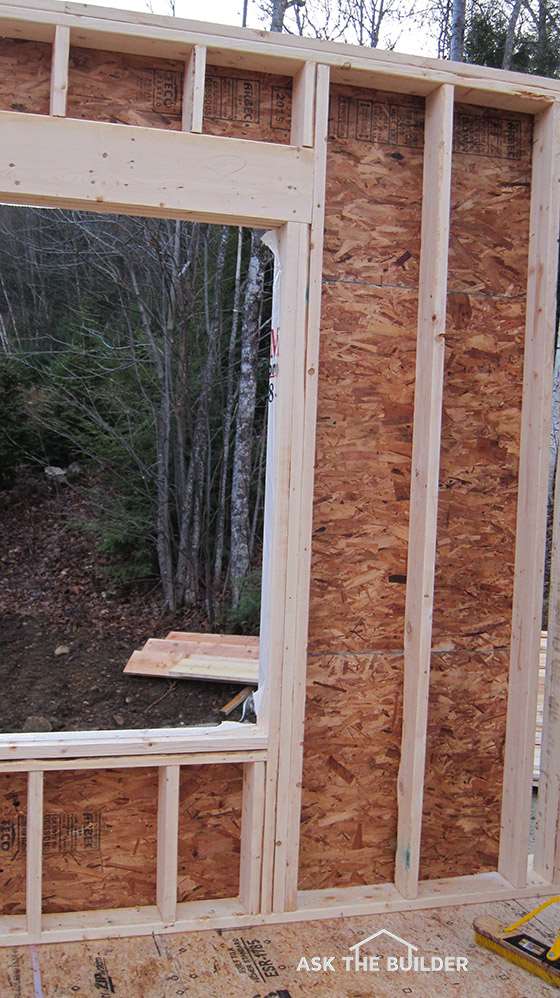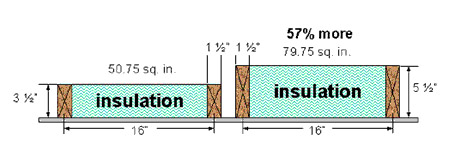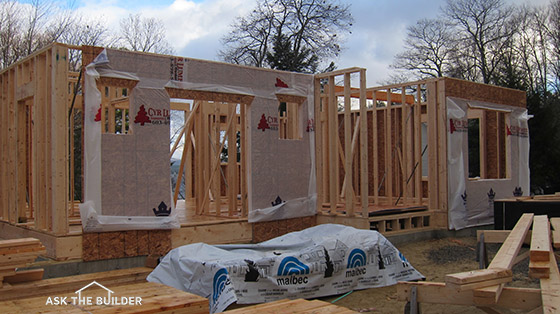2×4 vs. 2×6 Exterior Walls

Here's a typical 2x6 exterior wall before anything is put in the cavity. A 16-foot-long by 9-foot-tall wall with sheathing on it can easily weigh 200 pounds. (C) Copyright 2017 Tim Carter
2x4 and 2x6 framing looks the same but there are significant extra costs to build with 2x6s. How long before you get a payback is a great question.
Revised February 2018
2x4 vs 2x6 Framing TIPS
- Upgrade to 2x6 is not cheap
- Long-term payoff with energy savings
- Watch Wall Comparison VIDEO BELOW
- ROI period a function of where you live
- CLICK HERE to Get Tim's FREE & FUNNY Newsletter!
DEAR TIM: My husband and I are getting ready to build a new home. We want to spend as little as possible on heating and cooling fuel costs. 2x6 wall studs are two inches deeper than standard wall studs allowing you to add more insulation.
How much does it really cost to increase the exterior wall thickness of a house? Is it worth the extra money? What else can we do to lower fuel costs? Karen V., Springfield, IL
Related Links
High-Quality 2x4 Wall Construction Tips
Lumber Shrinkage & New Construction Walls
Free & Fast Bids
CLICK HERE to get FREE & FAST BIDS from rough carpenters that can build 2x6 walls.
DEAR KAREN: There are several things you need to consider when calculating the cost of increasing the exterior wall thickness of a house. The wall studs, top and bottom wall plates, insulation, and window and door extension jambs will all cost more money.
Once you have calculated the total added cost, you need to calculate how soon you might receive a payback. The soundness of the investment depends upon where you live and how close you are to sea level.

You don't have to have a PhD in math to realize a 2x6 wall cavity has lots more insulation space than that of a 2x4 wall cavity.
Many Things Add to 2x6 Framing Cost
Depending upon the size of your home, the cost to upgrade from 2x4 to 2x6 exterior walls can be significant. I decided to make a list of all the things you need to take into account when you upgrade from 2x4 to 2x6 exterior walls. You have to do your own material takeoff from your own plans to see what it will cost you:
- Bottom wall plates - in Northeast carpenters double them - one treated one regular
- Top wall plates - there are always two
- Window extension jambs
- Door extension jambs
- Extra insulation
Big Walls
2x6 walls are bigger than 2x4 walls. They're harder to lift and the headers on exterior walls require more work.
Great builders add 2.5 inches of closed-cell foam to the headers over windows and doors to help cut down on energy bills.
2x4 vs 2x6 Framing Video
This is the best video I could find when editing this column. I'm going to make my own one in the spring because this one is just not that great. However, it's still worth watching.
Calculating the Payback of 2x4 vs 2x6
To calculate the possible payback, you need to determine how much fuel you will save by increasing the wall thickness. This is a very time consuming and complicated process. Thankfully some scientists at the Building Research Council at the University of Illinois at Urbana-Champaign have done this. The results of their research are fascinating.
The scientists discovered that two very important things impact the payback period on wall insulation thickness upgrades. The most important item is simple: How cold does it get where you live and how long does it stay cold? There's an accepted method for measuring this from one city to the next
It is called the degree-day method. The meteorologists who work for the National Weather Service calculate this for each day of the heating season in your city.

This house has a piecemeal air barrier over the OSB sheathing. It might have been better to install plastic-coated OSB and then tape all the butt seams. © 2017 Tim Carter
Degree Days Are The Secret Code
Degree days are easy to calculate. You must determine the average temperature in degrees Fahrenheit for each day of the heating season. Add together the recorded high and low temperature for each day, and divide this sum by 2. Take this average daily temperature and subtract it from 65 degrees.
The result is the total degree days for that date. As the weather gets warmer, you obviously have fewer degree days per day. When the average daily temperature is 65 degrees or more, you have 0 degree days for that date.
The scientists at the University of Illinois determined that if you live in an area that experiences 5,750 or more degree days per year, then it begins to make economic sense to switch to 2x6 exterior walls.
CLICK HERE to see how many degree days you have where you live.
The more heating degree days you have above 5,750 the faster your payback will occur.
CLICK HERE to get FREE & FAST BIDS from rough carpenters that can build 2x6 walls.
Altitude Factors In Too
Altitude above sea level also makes a difference. Those people who live closer to sea level experience a more rapid conductive heat loss through the air. Because the air is denser as you get closer to sea level, heat travels from air molecule to air molecule more quickly.
For every 1,000 foot gain in altitude, five percent less heat is lost through conduction. This is one reason why solar energy houses work great in mountain areas and perform poorly in seaside situations. Houses at or near sea level need to be well insulated and tightly sealed.
People who live in the Sun Belt of the United States who tend to use air conditioners much more than furnaces face the same tough choices as you do. The cooler a person wishes the inside of their house to be, the more sense it makes to upgrade to 2x6 walls.
A person who prefers an indoor temperature of 70 F during the summer months will use considerably more energy than a person who can survive an indoor temperature of 76 F. The added insulation that a 2x6 wall provides will allow the 70 F house to achieve a much more rapid payback.
Don't Forget Attic Insulation
Probably the best way to save energy is to increase the amount of attic insulation. Heat loss is significant through insulated ceiling areas because of the large footprint of the attic space as a percentage of the building envelope.
Consider upgrading your blown-in attic insulation to a R-value of 38 or higher. I put in enough fiberglass in a my home I built in Cincinnati, OH to achieve a R-58 attic insulation value.
AAMA-Approved Windows and Doors
Windows and doors are another significant source of heat loss and heat gain. Purchase the best windows and doors you can afford.
Windows and doors that have the AAMA Gold label are the best hands down.
Look for ones that have the lowest air-infiltration loss through the weatherstripping and the highest overall R-value.
You should also invest in air-infiltration barriers. These will block those toasty warm air molecules from escaping your magnificent new home during the winter months!
The latest trend in house sheathing makes it so you don't need an air barrier. The OSB has a plastic coating on it that passes water vapor but doesn't allow liquid water to enter you home.
The carpenters apply a sticky tape to the seams of the plastic-coated OSB creating a wind-proof barrier.
CLICK HERE to get FREE & FAST BIDS from rough carpenters that can build 2x6 walls.
Column 217
18 Responses to 2×4 vs. 2×6 Exterior Walls